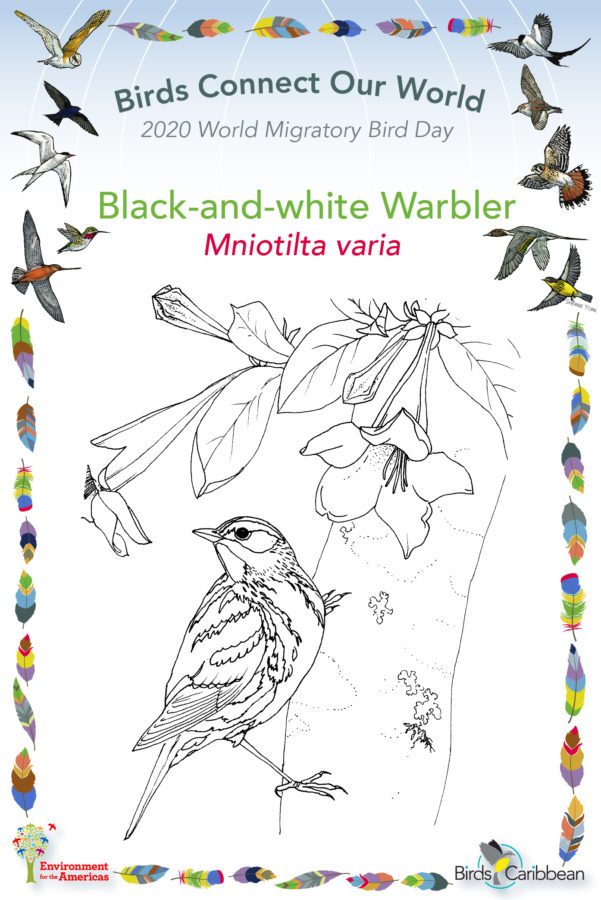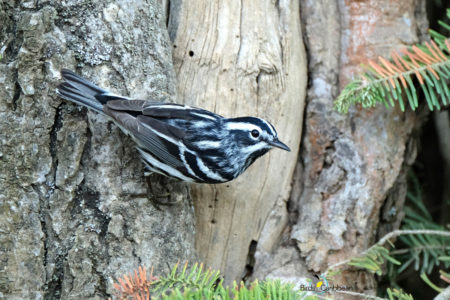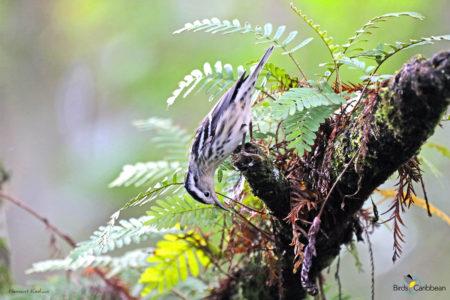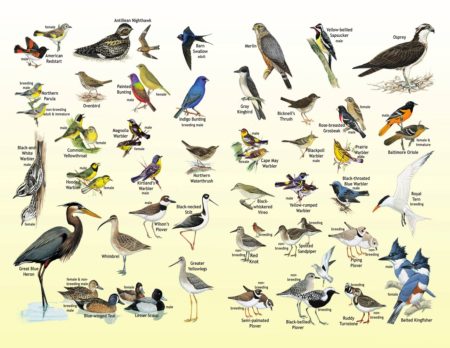Celebrate World Migratory Bird Day (WMBD) with us in our virtual “Birds Connect Our World” edition! Have fun learning about a new migratory bird every day. We have colouring pages, puzzles, activities, and more. Download for free and enjoy nature with your family at home.

Migratory Bird of the Day: Black-and-white Warbler

Our final ‘migratory bird of the day’ is the distinctive Black-and-white Warbler. These active little birds are easily recognised by the bold black-and-white stripes over their entire body and head. Look closely and you’ll see that some birds have black ear patches while others have gray. The ones with black are adult males. Females and immature birds are also paler and have a white throat.
Black-and-white Warblers creep up and down the trunks and branches of trees, probing in the bark with their slightly down-curved bill for insects and spiders. They can even hang upside down as they feed—an extra-long hind claw helps them hold onto and move around on bark. Their local name in Jamaica is ‘Ants Bird’ or ‘Ants Picker,’ reflecting their fondness for picking ants off of tree bark.
Black-and-white Warblers breed in forests across eastern parts of the US and Canada. Starting in late August, this long distance migrant heads south to winter in Florida, Mexico, Central America, northern South America, and the Caribbean. During winter these warblers can be found across the Caribbean, although they are more common in the Bahamas, Greater Antilles, Cayman Islands, and Virgin Islands. This species clearly enjoys the Caribbean, as June is the only month of the year when it has not been recorded in the region!
Black-and-white Warblers can be found in a wide range of habitats. As well as forests and woodlands, they can be seen in gardens, shade-coffee plantations, wetlands, and mangroves. These warblers are very territorial, even during winter! They will chase away any other Black-and-white Warblers who come into their ‘patch,’ even if they are feeding with a group of other species. Learn more about this species, including its range, photos, and calls here.
Colour in the Black-and-white Warbler!
Download the page from Migratory Birds of the West Indies Colouring Book. Use the photos below as your guide, or you can look up pictures of the bird online or in a bird field guide if you have one. Share your coloured-in page with us by posting it online and tagging us @BirdsCaribbean #WMBD2020Carib
Listen to the calls of the Black-and-white Warbler
The calls of the Black-and-white Warbler are a sharp “chit” or “pit.”
Puzzle of the Day
Click on the images below to do the puzzles. You can make the puzzle as easy or as hard as you like – for example, 6, 8, or 12 pieces for young children, all the way up to 1,024 pieces for those that are up for a challenge!


Activity of the Day
FOR KIDS: We have met many migratory birds during this series. You can see all of them here in this colourful graphic! Use this as a reminder and test your memory with our Migratory Bird Memory Game . Can you match up all the pictures of the different migratory birds to their names? Each correct match will reveal an interesting fact.
FOR KIDS AND ADULTS:
- Take a walk and see if you can spot any migratory warblers, look up in the trees to look for any Black-and-white Warblers creeping along the trunk or branches. Use a bird field guide or the FREE Merlin bird ID app to help you identify the birds you are seeing.
- Enjoy the videos below of Black-and-White Warblers in the wild! The first shows a bird feeding on a tree – do you think it’s a male or a female? You can see the typical ‘creeping’ behaviour of this Warbler, as it moves across the bark looking for food. The second video shows a male perched up in a tree, you can hear him singing. They mainly sing only during the breeding season, in winter you might hear their “chit” calls.
- Visit MigratoryBirdDay.org for many more free activities and resources to learn about migratory birds, their threats and conservation actions you can take.


